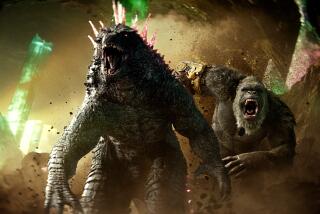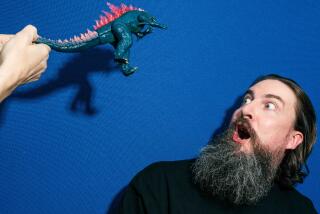Godzilla Goes on the Attack in Happily Familiar Territory
- Share via
This wasn’t supposed to happen. The king was dead, they told us, long live the king. After starring in nearly two dozen Japanese films over 40 years, after fighting off Mothra, Megalon, Hedora, Biolante and others too numerous to mention, Godzilla, the once and future King of the Monsters, died in 1995. It wasn’t beauty that killed the beast. Not this time anyway. It was Hollywood.
For in anticipation of competition from the much-ballyhooed 1998 mega-expensive “Godzilla” directed by Roland Emmerich, Toho Pictures, Mr. G’s longtime home, killed the trusty veteran off in “Godzilla vs. Destroyer.” Or so they thought.
But Hollywood’s “Godzilla” didn’t do too well in the face of some truly fire-breathing reviews, and Sony, which financed it, decided that it was the better part of valor to give the big guy back to the people who know how to treat him with respect.
In Japan, under his real name of Gojira (producer Joseph E. Levine came up with his American alias), Godzilla has been a national treasure since the first film came out in 1954. Schoolchildren could probably name the different actors who’ve worn the Godzilla suit, prowling around Tokyo knocking down miniature buildings, and if pressed could tell you that the sounds of the monster’s awful footsteps are made by beating a kettle drum with a heavy rope knotted at one end.
So it’s especially satisfying to report that “Godzilla 2000” is yet another traditional Japanese production, weakly plotted, woodenly acted and indifferently dubbed. Yet, for all of that, there is something pleasant and familiar about this old-fashioned home-cooking approach, as well as something powerful about the Japanese attitude toward this particular monster. When they star you in 23 movies, there has got to be a reason.
Because the 21st century is upon us, the new Godzilla has been given a make-over. He’s lost some height (down from 328 feet to approximately 170), but his mouth is now wider (the better to bite you with), his skin coarser, his dorsal fins longer and spikier. And even though computer-generated imagery is no longer taboo, the Godzilla suit has been handed down to the next generation, a former stuntman for action star Sonny Chiba named Tsutomu Kitagawa, who reports, for those who had their doubts, “playing Godzilla is not for someone who’s claustrophobic.”
Big and destructive though he is, Godzilla can be reclusive and hard to find, which is presumably why the Godzilla Prediction Network, or GPN, came into being. It’s not much of a network, really, mostly renegade scientist Yuji Shinoda (Takehiro Murata) and his precocious daughter Io (Mayu Suzuki), who do sci-fi things like “monitor density changes in the plasma” to keep track of the behemoth.
Shinoda is a renegade because he wants to study Godzilla, to find out what makes him tick, and his knowledge is already extensive. “When Godzilla attacks,” the scientist somberly announces, “he advances, not retreats.” Better hold the presses for that one.
On the other side, Mitsuo Katagiri (Hiroshi Abe), head of the government’s powerful Crisis Control Intelligence Agency, wants to get it over with and kill Godzilla as quickly as possible. He and sidekick Shiro Miyasaka (Shiro Sano) are eager to use the army’s latest armor-piercing missiles to test how strong the monster’s coarse new skin really is.
One of the intriguing subtexts of “Godzilla 2000” is that even with that toothier new mouth Godzilla is such a familiar face in Japan that no one ever seems surprised to see him. Not even the man who says, “The damn teriyaki is cold again,” before Godzilla flattens a pub seems at all put out as the walls crash down around him.
“Godzilla 2000’s” plot is triggered by an irritable career-girl photographer named Yuki Ichinose (Naomi Nishida), who says things like “Bite me” (surely not a direct translation from the Japanese) and worries, when her plan to get Godzilla snapshots doesn’t pan out, “God must be punishing me for being ambitious.”
Soon enough, however, Yuki’s and everyone else’s concerns matter little as a vicious and gigantic alien creature named Orga, in an especially bad mood because it’s been asleep for 60 million years and missed a lot of cool stuff, tries to take over the world. This, we are told in no uncertain terms, “could be the end of civilization.”
But the truth is that after decades spent using Tokyo as his literal stomping grounds, Mr. G., beady eyes and radiation breath notwithstanding, has become a friend of the family. He’s like a mean-tempered junkyard dog who may have differences with the human race but certainly isn’t going to let another alien horn in on his territory without a fight.
It’s in watching the climactic battle between Orga and Godzilla that the essence of this series’ long-lived appeal comes into focus. For there is a surprising level of the nightmarishly primeval in these tussles, a sense of watching an ancient religious rite with mythic roots, that makes the made-in-Japan fights stand apart from the kinds of surfacy battles American monsters engage in.
“The American Godzilla was a target the humans had to beat, and, ultimately, they did,” executive producer Shogo Tomiyama explains. “But the Japanese Godzilla is totally different--he is the star of the movie.” Which may be why Japanese audiences feel, as one of the characters puts it, “Godzilla is inside each one of us.”
Or maybe it’s just a bad case of heartburn.
* MPAA rating: PG for monster violence and mild language. Times guidelines: Climactic Orga/Godzilla battle might be disturbing to young viewers.
‘Godzilla 2000’
Takehiro Murata: Yuji Shinoda
Hiroshi Abe: Mitsuo Katagiri
Shiro Sano: Shiro Miyasaka
Naomi Nishida: Yuki Ichinose
Mayu Suzuki: Io
A Toho Co. Ltd. presentation of a Toho Pictures Inc. production, released by TriStar Pictures. Director Takao Okawara. Producer Toshihiro Ogawa. Executive producer Shogo Tomiyama. Screenplay Hiroshi Kashiwabara & Wataru Mimura. Cinematographer Katsuhiro Kato. Editor Yoshiyuki Okuhara. Music Takayuki Hattori. Art director Takeshi Shimizu. Set decorator Chuichi Yanagibori. Running time: 1 hour, 37 minutes.
In general release.
More to Read
Only good movies
Get the Indie Focus newsletter, Mark Olsen's weekly guide to the world of cinema.
You may occasionally receive promotional content from the Los Angeles Times.









